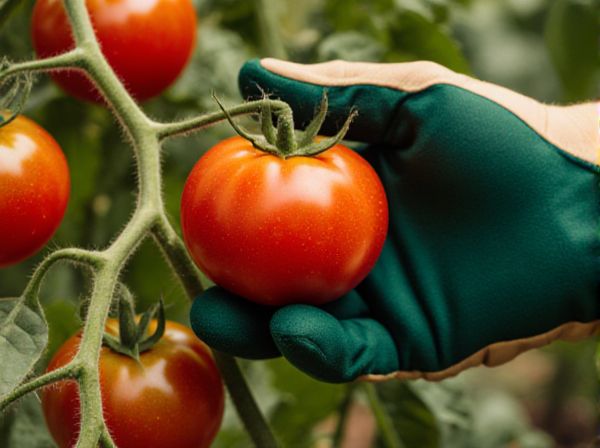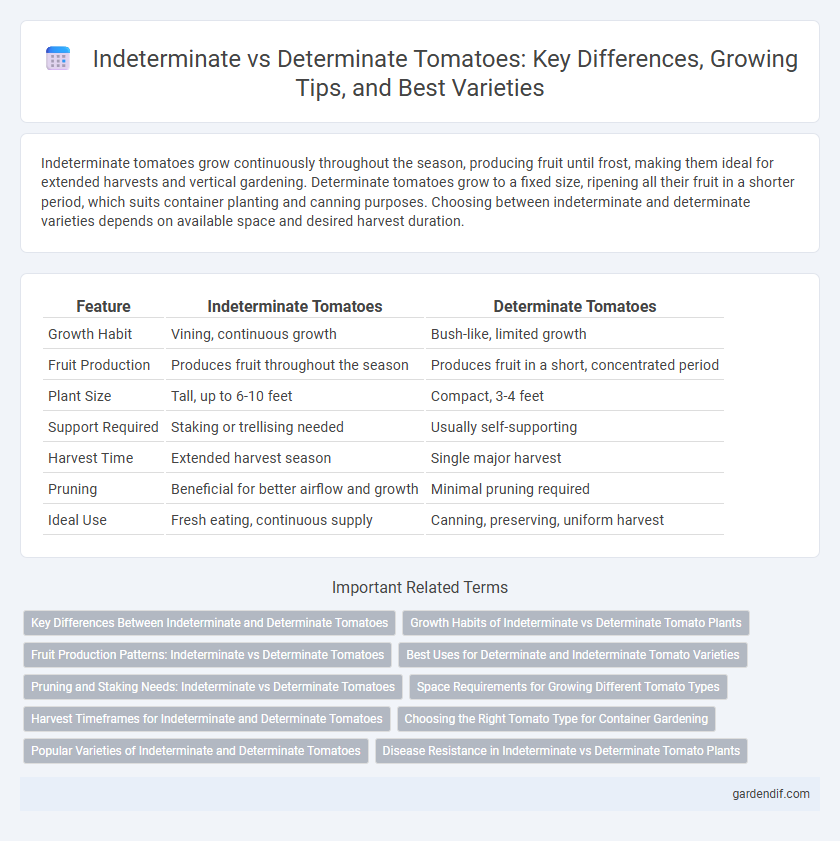
Indeterminate tomatoes vs Determinate tomatoes Illustration
Indeterminate tomatoes grow continuously throughout the season, producing fruit until frost, making them ideal for extended harvests and vertical gardening. Determinate tomatoes grow to a fixed size, ripening all their fruit in a shorter period, which suits container planting and canning purposes. Choosing between indeterminate and determinate varieties depends on available space and desired harvest duration.
Table of Comparison
| Feature | Indeterminate Tomatoes | Determinate Tomatoes |
|---|---|---|
| Growth Habit | Vining, continuous growth | Bush-like, limited growth |
| Fruit Production | Produces fruit throughout the season | Produces fruit in a short, concentrated period |
| Plant Size | Tall, up to 6-10 feet | Compact, 3-4 feet |
| Support Required | Staking or trellising needed | Usually self-supporting |
| Harvest Time | Extended harvest season | Single major harvest |
| Pruning | Beneficial for better airflow and growth | Minimal pruning required |
| Ideal Use | Fresh eating, continuous supply | Canning, preserving, uniform harvest |
Key Differences Between Indeterminate and Determinate Tomatoes
Indeterminate tomatoes grow continuously throughout the season, producing fruit on vines that can reach several feet in length, requiring staking or support, while determinate tomatoes grow to a fixed mature size and produce fruit mostly all at once. Indeterminate varieties offer extended harvest periods suitable for canning and fresh eating, whereas determinate varieties are preferred for container gardening and processing due to their compact growth and concentrated yield. Fruit size and flavor intensity often vary, with indeterminate tomatoes typically delivering larger, more flavorful tomatoes compared to the smaller, uniform fruits of determinate plants.
Growth Habits of Indeterminate vs Determinate Tomato Plants
Indeterminate tomato plants exhibit continuous growth, producing vines that can reach several feet long and yield fruit throughout the growing season. Determinate tomato plants grow to a compact, bush-like size, typically stopping growth once fruit sets on the top bud, leading to a concentrated harvest period. The distinct growth habits influence pruning, staking requirements, and harvest timing for each tomato type.
Fruit Production Patterns: Indeterminate vs Determinate Tomatoes
Indeterminate tomatoes produce fruit continuously throughout the growing season, allowing for extended harvest times ideal for fresh consumption and successive planting. Determinate tomatoes yield a concentrated fruit set over a shorter period, making them suitable for processing and large, single-harvest demands. This difference in fruit production patterns influences garden planning, resource allocation, and market supply strategies.
Best Uses for Determinate and Indeterminate Tomato Varieties
Determinate tomato varieties are ideal for container gardening and small spaces, producing a concentrated harvest perfect for sauces and canning. Indeterminate tomatoes continue growing and producing fruit throughout the season, making them best suited for fresh eating, slicing, and extended harvest periods. Gardeners seeking steady, long-term yields should choose indeterminate types, while those preferring a single, abundant crop should opt for determinate varieties.
Pruning and Staking Needs: Indeterminate vs Determinate Tomatoes
Indeterminate tomatoes require regular pruning and sturdy staking due to their continuous growth and sprawling vines, which can reach up to 6-10 feet. Determinate tomatoes have a more compact growth habit, producing fruit in a shorter timeframe and needing minimal pruning with basic support structures. Proper staking for indeterminate varieties prevents disease and improves air circulation, while determinate plants thrive with cage-style supports that accommodate their bushier form.
Space Requirements for Growing Different Tomato Types
Indeterminate tomatoes require more vertical space as they continually grow and produce fruit throughout the season, often needing trellising or staking for support. Determinate tomatoes are more compact and bush-like, making them suitable for container gardening or smaller garden plots with limited space. Selecting the right tomato type based on available growing space optimizes plant health and yield efficiency.
Harvest Timeframes for Indeterminate and Determinate Tomatoes
Indeterminate tomatoes have an extended harvest timeframe, producing fruit continuously throughout the growing season until frost, which can last several months. Determinate tomatoes, by contrast, yield a concentrated harvest period, typically ripening all their fruit within a 1 to 3-week window. This difference in harvest duration impacts both garden planning and commercial production strategies.
Choosing the Right Tomato Type for Container Gardening
Indeterminate tomatoes grow continuously, producing fruit throughout the season, making them ideal for gardeners seeking consistent harvests in containers. Determinate tomatoes grow to a fixed size and set fruit all at once, which suits limited space and shorter growing periods for container gardening. Selecting determinate varieties like 'Roma' or indeterminate types like 'Cherry' depends on container size and harvest timing preferences.
Popular Varieties of Indeterminate and Determinate Tomatoes
Popular indeterminate tomato varieties include 'Cherokee Purple,' 'Brandywine,' and 'Sungold,' known for their continuous growth and fruit production throughout the season. Determinate tomato varieties such as 'Roma,' 'Celebrity,' and 'Rutgers' are prized for their compact growth habit and concentrated fruit yield. Gardeners select indeterminate types for extended harvests and determinate types for efficient space use and uniform maturation.
Disease Resistance in Indeterminate vs Determinate Tomato Plants
Indeterminate tomato plants generally exhibit greater disease resistance compared to determinate varieties due to their extended growth period and continuous production of new foliage, which allows for better recovery from infections. Determinate tomatoes, being more compact and producing fruit over a shorter period, can have increased susceptibility to diseases like blight and wilt, especially under humid conditions where air circulation is limited. Selecting disease-resistant cultivars within the indeterminate category, such as 'Brandywine' or 'Cherokee Purple,' can further enhance resilience against common tomato pathogens.
Indeterminate tomatoes vs Determinate tomatoes Infographic

 gardendif.com
gardendif.com